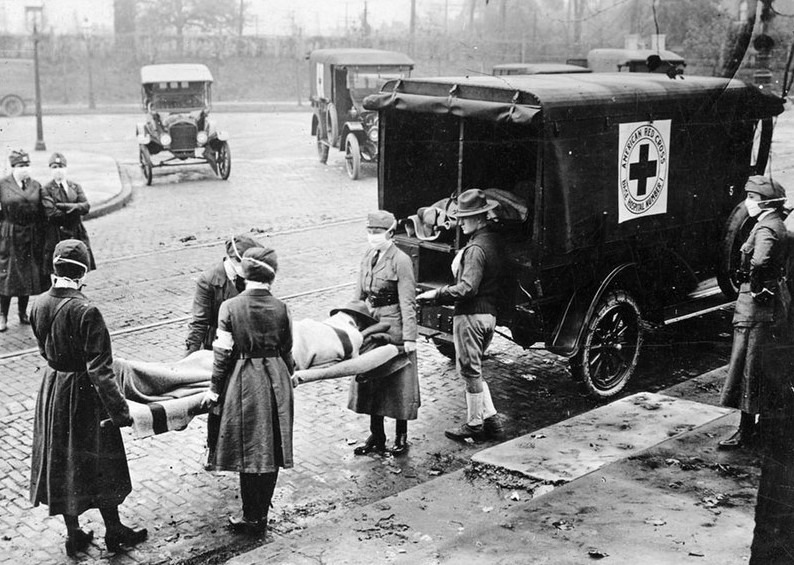Pandemics have infected society throughout history, but the influenza of 1918-1919 was the most devastating in known human history.
It is known as the Spanish flu or the influenza of 1918, which was the most devastating pandemic in modern history. It spread even to the most isolated human communities and estimated to have killed 20-50 million people, and infected as much as 40 percent of the global population over the next 18 months.
It killed 675,000 in the US alone which is more than the combined deaths from World War I, World War II, Vietnam, Korea, and wars in Iraq and Afghanistan.
In Spain where most people believed the flu had originated, had 260, 000 deaths caused by influenza; 75% of them died during the second period of the epidemic, and 45% died during October 1918 alone.
The most controversial question: Where did it come from?
From Spain?
The pandemic took place during WWI when Spain was one of the few major countries in Europe who remained neutral on the war. Wartime censors from Allied and Central Powers nations suppressed news of the flu to avoid affecting morale. However, Spanish media during the time was free to report on it in detail, and on May 22 May 1918, the epidemic was a headline in Madrid’s ABC newspaper.
News coverage on the flu escalated after Spanish King Alfonso XIII came down with a nasty case a week later. Because nations were under a media blackout, people could only read and resort to in-depth accounts from Spanish news sources, therefore they made assumptions that the country was the pandemic’s ground zero. Meanwhile, the Spanish believed the virus had spread to them from France, so they took to calling it the “French Flu.”
It was assumed that influenza most likely reached Spain from France, perhaps as the result of the heavy railroad traffic of Spanish and Portuguese migrant workers to and from France.
From America?
With the first recorder cases on March 11, 1918, at Fort Riley in Kansas, researchers firmly believed that the flu originated in the United States despite its name “Spanish flu”.
Due to overcrowding and unsanitary surroundings, the virus created a fertile breeding ground resulting in the deaths of 522 men within a week. They were admitted to the camp hospital suffering from the same severe influenza.
Similar outbreaks were also reported in Virginia, South Carolina, Georgia, Florida, Alabama, and California, soon after the said incidence. Navy ships docked at East Coast ports also reported outbreaks of severe influenza and pneumonia among their crews. The virus was largely overshadowed by hotter current affairs such as Prohibition, the suffragette movement, and the bloody battles in Europe because it seemed to target military personnel and not civilians.
From China?
The latest theory on the origin of the 1918 pandemic emerged in 2014. According to the National Geographic, there were previously undiscovered records linked the flu to the transportation of Chinese laborers, the Chinese Labour Corps, across Canada in 1917 and 1918.
Based on the book “The Last Plague” by Mark Humpries, there were laborers mostly Chinese (farmworkers who came from remote parts of rural China) who were required to repair damaged tanks, unload trains, dig trenches, lay tracks, and build roads. They spent six days inside the sealed train containers, transported across the country before going to France. There were an estimated 90 000 workers who were mobilized to the Western Front.
Humphries explained that in 25,000 Chinese laborers during 1918, about 3000 ended their Canadian journey due to medical quarantine. A strong racial stereotyping was also present at that time that is why their illness was blamed an associated with “Chinese laziness” and Canadian doctors did not consider the symptoms to be serious.
Many were sick, and hundreds were soon dying, by the time the Chinese laborers arrived in northern France in early 1918.
Symptoms of the flu
Various reports stated that the first wave of the 1918 pandemic occurred in springtime. It was generally mild as the infected human experienced typical flu symptoms like chills, fatigue, and fever and usually recovered after a few days. Recorder death during this time was low.
However, the second wave of influenza which took place during the fall season was highly contagious. Initial symptoms include a sore head and tiredness, a dry, hacking cough, appetite loss, stomach problems, and excessive sweating on the next day.
The infected people developed respiratory organ damaged and had pneumonia. Some infected people died within hours after developing symptoms experienced.
In 1918 alone, the average life expectancy in America dropped by a dozen years. Having killed an estimated 1% to 3% of the world’s population, the Spanish flu still remains the most deadly flu pandemic in known human history.
